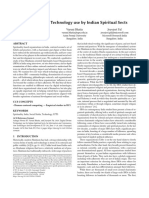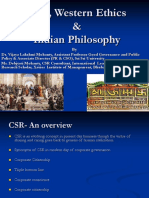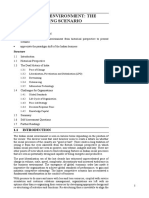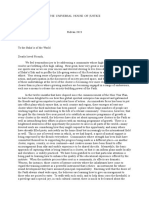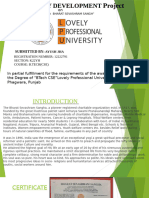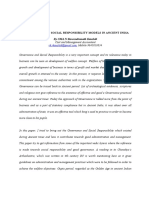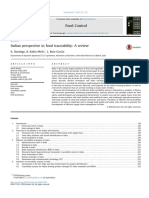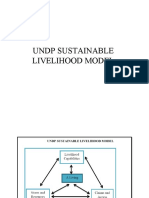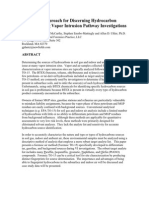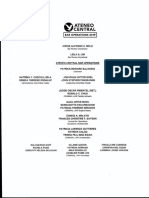0 ratings0% found this document useful (0 votes)
103 viewsEfforts For Development': Swadhyaya
Efforts For Development': Swadhyaya
Uploaded by
Sri HimajaThe Swadhyaya movement in India puts people at the core of development and is inspired by God. It has established over 15,000 programs that empower individuals through self-study and collective action. This has led to the spontaneous emergence of institutions created and managed by local communities to meet economic, social and environmental needs. The movement challenges traditional views of human motivation and has been successful in creating wealth and institutions through collective spirit and enlarged identity rather than self-interest alone.
Copyright:
© All Rights Reserved
Available Formats
Download as PDF, TXT or read online from Scribd
Efforts For Development': Swadhyaya
Efforts For Development': Swadhyaya
Uploaded by
Sri Himaja0 ratings0% found this document useful (0 votes)
103 views4 pagesThe Swadhyaya movement in India puts people at the core of development and is inspired by God. It has established over 15,000 programs that empower individuals through self-study and collective action. This has led to the spontaneous emergence of institutions created and managed by local communities to meet economic, social and environmental needs. The movement challenges traditional views of human motivation and has been successful in creating wealth and institutions through collective spirit and enlarged identity rather than self-interest alone.
Original Title
Swadhyaya
Copyright
© © All Rights Reserved
Available Formats
PDF, TXT or read online from Scribd
Share this document
Did you find this document useful?
Is this content inappropriate?
The Swadhyaya movement in India puts people at the core of development and is inspired by God. It has established over 15,000 programs that empower individuals through self-study and collective action. This has led to the spontaneous emergence of institutions created and managed by local communities to meet economic, social and environmental needs. The movement challenges traditional views of human motivation and has been successful in creating wealth and institutions through collective spirit and enlarged identity rather than self-interest alone.
Copyright:
© All Rights Reserved
Available Formats
Download as PDF, TXT or read online from Scribd
Download as pdf or txt
0 ratings0% found this document useful (0 votes)
103 views4 pagesEfforts For Development': Swadhyaya
Efforts For Development': Swadhyaya
Uploaded by
Sri HimajaThe Swadhyaya movement in India puts people at the core of development and is inspired by God. It has established over 15,000 programs that empower individuals through self-study and collective action. This has led to the spontaneous emergence of institutions created and managed by local communities to meet economic, social and environmental needs. The movement challenges traditional views of human motivation and has been successful in creating wealth and institutions through collective spirit and enlarged identity rather than self-interest alone.
Copyright:
© All Rights Reserved
Available Formats
Download as PDF, TXT or read online from Scribd
Download as pdf or txt
You are on page 1of 4
SWADHYAYA EFFORTS FOR DEVELOPMENT'
KV Raju, IRMA
The simplicity and truth of the central message of Swadhyaya is
through curricular and extra-curricular activities are
that there is something good and noble in each of us waiting to functioning.
be awakened and that by recognising these within ourselves and
in others, we raise our relationships to a higher plane, creating a 15,400 Divine Brain Trusts where young people meet every
more wholesome society. In a sense, such recognition is also week once to discuss and exchange thoughts are existing.
central to building partnerships. Dadaji, Pandurang Shastri 474 Ninnal Neer (Pure water tanks — may or may not be for
Athavale, has distilled the ancient wisdom of our tradition and irrigation) tanks either mostly deepened or rarely created by
used its essence to refurbish man's selfhood. He inspired devotees from a cluster of villages for a period of ten days in
instrumental devotion or krutiBhakti based on Swa - adhyaya a year successively for many years.
(self-study) by which common man is empowered to create a
Most development efforts begin their day by assuming that man
better society and social institutions.
is guided in the conduct of life by "bounded rationality" and
Pandurang Shastri Athavale received the Ramon Magsaysay "opportunism bordering on guile" and play around with designs
Award in 1996 and the Templeton Award in 1997. He said in his of institutions. But the model of man remains a "human being
Templeton Prize address "It is my experience that awareness of propelled by self interest". These efforts seem fruitless, especially
nearness of God and reverence for that power when the goal is to build institutions that put
creates reverence for self, reverence for others, Swadhyaya movement puts people at the core of their agenda. Swadhyar
reverence for nature and reverence for entire people at the core of movement has overcome this limitation by —
creation". This reverential attitude, invoked in development and had God as the starting with the model of man itself and by
large numbers, is underlying the motivation that source of their inspiration. giving the individual a new self-hood. By
brought in sustained collective action resulting enabling the man to discover the good and the
in creation of impersonal wealth. noble residing in self and others, by inspiring moderation over
excess and aggression, by teaching the value of transcending
Beginning in 1958, Athavale established dozens of programmes
ego but protecting one's honour and dignity at all cost, and by
which have God as the source of their inspiration, including:
transmuting devotion into self-less but socially purposive action,
Bhaktipheri (goodwill visits) by thousands of followers among the movement has created a personal and social identity of the
approximately 2,20,000 of them throughout India and extending individual which challenges stereotyped models of man.
to the United States, Canada, Germany, Sweden, Portugal,
Kenya, South Africa, Bahrain, United Arab Emirates, Fiji, West The powerful social force that so unleashed has begun to produce
Indies and Surinam. spontaneous emergence of a variety of people's institutions,
Amruthalayam (village temples) built by the joint efforts of needing no coaxing, no orchestration, no promotion and all using
self-propelled local initiative and internally generated resources.
the villagers where persons of all creeds, castes and economic
status meet to worship in unity and discuss ways to improve In a world where common property institutions — including the
village life —104 of them are existing. family—are falling apart, there is small groundswell of initiatives
by ordinary farmers, fishermen and artisans to create common
Yogeswar Krushi (farms devoted to God) where the devotees property institutions by offering their "respective efficiencies",,,,,
from the village give a few days of labour each in a year as a to God and His creation.
concrete expression of their devotion to God. Produce is
offered to the needy as prasaad (part-taking of offering to Paradigm relevant to the Indian context
God and thus sanctified)- 3,396 such farms are established in S ocial and economic issues cannot be separated from political
as many villages. an d religious concerns as many modern planners and thinkers
Matsyagandhas (floating temples of God), fishing boats built eem to assume. The current global economic system and its
by fishermen and women in the villages. Fishermen operate a ssociated development paradigm are often at odds with
these boats voluntarily a few days each in a year as expression tr aditional knowledge that is holistic encompassing both logical/
of devotion to God. Again, harvest is shared by the needy as e mpirical and normative/affective. The ethical and the spiritual
prasaad —71 such fishing boats are in operation. c oncerns are central values in many developing countries,
Vrikshmandirs (orchards of God) which are raised by e specially among the rural community. Unless these values are
Swadhyayees (devoted followers) by each of them offering a rediscovered, development, in the real sense, will elude us
few days of voluntary labour in a year- 16 orchards are Chowdhry, 1996, 1997).
established. Th ere are many indigenous movements (like the Ramakrishna
21,300 Behna Kendras where women devotees meet to discuss M ission, the Swadhyaya Movement, the Bahai's, disciples of Sri
and help one another to solve their problems are working. A urobindo in Pondichery) built on the sacred, spiritual and moral
11,200 Bal Samskar Kendras where children get socialised as pects (normative/affective considerations and identity) - but
1 This paper is a part of the research project on Rural Livelihood Systems and Sustainable Management of Natural Resources in Semi-Arid Areas of India.
The project is funded by Swiss National Science Foundation under Priority Programme on Environment, Module7.
NETWORK Vol.5 No.3 I
not necessarily religious. These, in general, ignore or deliberately motivation. It is argued that perceived collective efficacy and
discourage participation based on rational considerations of self- social rewards and sanctions should be given a central place in
interest and encourage collective spirit through enlargement of models of collectivistic work motivation. It is further argued that
individual identity beyond personal. moral commitments and identity affirmation can not be reduced
to calculative considerations and doing so masks the potential
A report about Swadhyaya's activities and achievements
importance of these factors in explanation of collective action
(Outlook, April 3, 1995) states: "In some 80000 villages where it
(Shamir, 1990).
holds sway, Swadhyaya has used the notion of human dignity
and devotion as a creative force to generate vast amounts of There is a traditional Hindu theory that explains why a particular
impersonal wealth among farmers and fisher folk; promoted action does or does not take place. There are three prerequisites:
afforestation and gender equality; demolished caste barriers and motivation (kcha or strong desire) leading towards search for
put an end to drinking (alcoholism) and wife beating". In addition, knowledge (Jnana or know-how) and application skill (Kriya or
the engineers and technicians in the movement have helped to creative ability) finally culminating in action resulting in fulfillment
harvest rainwater to recharge 94465 wells (mostly private) and (Ranganadhananda, 1977). Inadequacy in any of these three can
208 dry lakes (common ponds). All this is achieved with the help lead to either inaction or action not culminating in fulfillment. It is
of the people. quite possible to check the adequacy or inadequacy of these in
individuals or groups by suitably developed instruments before
India is rich in such institutions serving economic, social and
deciding on what should be the thrust of outside intervention in
ecological needs. These institutions are rooted in the spiritual
terms of motivational education or transfer of technology (know-
and sacred values based on normative/affective considerations
how) or resource supplementing
as well as in the local traditions of community
(provisioning).
sharing and control which are largely an Swadhyaya has used the notion of
'utcome of concretising such normative/ human dignity and devotion as a Mahesh looked at the Eastern (largely Hindu
affective considerations and not logical/ creative force to generate a desire and Chinese) and Western theories on
empirical considerations. They have not leading to knowledge and finally motivation and proposed an integrated model
motivated the individuals by appealing to their action by individuals in of human motivation (Mahesh, 1993). Sharma
individual-rational considerations (the domain communities. explains human motivation based on
of neoclassical paradigm) but by activating traditional Hindu ideas and advocates a
their collectivistic normative, affective considerations (the domain holistic model of inspirational motivation (Sharma, 1996). An
of deontological ethic paradigm) through transformation of individual must have a reasonably comfortable self-attitude vis-
identity (Etzioni, 1988). These efforts succeeded on a sufficiently a-vis others in terms of four life positions advocated by
large scale to warrant our attention for further understanding. transactional analysts like Eric Berne and a world-view starting
Many of these efforts are structured around avoiding and with immediate and proximate contextual reality which in turn
reversing of the trends in over use of natural resources and influences the perception of one's goal, role and identity (Erikson,
around using the same in a sustainable manner by modifying 1963; Sudhir ICalcicar, 1968).
value orientation of individuals.
Attitude towards natural resources
In 'The Theory of Moral Sentiments,' Adam Smith, himself,
Attitudes and beliefs associated with the use of natural resources
observed that people act out of a conscience and are related to like land, water, trees, animals and other human beings can be
one another not merely via a market - in exchange relations, trying meaningfully classified as
to maximise their interest; but also as people whose psychic
Extractive - beyond the rate at which nature replenishes them,
well-being is deeply dependent on the approval of others, which
I turn is based on acting morally, and not on enhancing wealth. Balancing - restricting the use moderately to be within
"How so ever selfish man be supposed, there are evidently some recognised limits of replenishment,
principles in his nature, which interest him in the fortune of others, Conservative - accepting some responsibility for
and render their happiness necessary to him" (Smith, [1759] 1976). supplementing the natural processes of replenishment.
In short, people typically do not make rational decisions all the Underlying these attitudes and beliefs is the understanding of
time. Sometimes, they do act relatively more rationally and we are nature and its processes as
able to identify the conditions and forces that promote such higher Abundant and to be used for the unrestrained enjoyment of
levels of rationality. In other times, we find that people man,
significantly drawing on emotions arising out of value judgements
Limited and interdependent marked by continuous reciprocal
or ideology which largely define their identity for them. This is,
exchange, and
often, an effective, not a distorted, way of making choices and
taking decisions. People appear to be striving towards balancing Purposive, where man needs to align his entire existence to
multiple considerations rather than maximise or minimise any one become a willing and fit instrument.
of them. Some considerations are predominant in a particular Swadhyaya efforts mould these attitudes to self and nature by
situation falling in the domain of a specific set of considerations transforming the worldview of individuals with the idea of God
but others do not get negated completely. being immanent in the universe. By doing so, Swadhyaya brings
Shamir mentions calculative considerations, moral commitments improvements in both social and ecological environment. Today's
and the affirmation of identities as sources of collectivistic work problems of pollution and depletion of natural resources and
NETWORK Vol.5 No.3
growing violence and decreased goodwill towards others in the group is perceived. At stake in participation in-group efforts is a
social spheres perhaps can only be adequately addressed by perceived challenge to one's Worldview, Values and Identity. Some
living with a philosophy that embraces both with an all inclusive of these may get reinforced and validated, while some get
reverential attitude in place of antagonistic feelings towards both questioned and invalidated. So participation offers a mix of
of them. positive—negative experience. The degree of comfort one has
with the self-concept and the positive feeling towards the group
Threshold level of coordinated efforts influence the degree of participation.
As a particular person's action and its impacts, which are often
diffused over a long period of time and space, and are very minute Non-threatening environment at least in the initial stages, gives
compared with the totality, it is difficult to visualise the reciprocal the individual some assurance and possibly prompts them to
consequences clearly. Once the reciprocal balances are disturbed exploratory participation. If one gets convinced of the desirability
beyond the limits within which they can be re-established, the of such metamorphosis, one continues the participation. Most
consequential changes manifest. Often the threshold limits of of the above processes simultaneously and continuously occur
effort required for restoration of disturbed cycles or establishing in the context that an individual finds him. Worldview, values
new cycles are much larger and beyond the scope of a few and Identity do not remain static and evolve as a complex product
individuals. This calls forth for sustained, co-ordinated of interaction of the individual with the rest.
"collective" effort on a scale that matches the requirement to
restore or establish balance. Swadhyaya movement has adopted persuasive methods — without
a trace of coercion — to propagate their message and induce new
Swadhyaya has achieved this difficult matching in several persons to join their efforts. NO TARGETS to achieve or complete
noteworthy long-term efforts like in except the self-imposed ones offer a
establishing Yogeswar krishi farms (where pressure free atmosphere to exercise one'a
Swadhyaya efforts mould attitudes to
farmers offer kruthiBhakti), Vrikshamandirs own volition. Free entry and free exit offerri
self and nature by transferring the
(where kruthiBhakti is directed towards complete freedom and promotes self-
worldview of individuals.
raising orchards) and Sridarshanam farms responsibility to honour the commitments
(where farmers from about 20 villages offer once made. Non-hierarchical functional
kruthiBhakti). The self-organisation of Swadhyayees in totally structure promotes the spirit of brotherhood.
self-reliant ways in mobilising material requirements and human
efforts with requisite skills is highly commendable. This is evident Regular interactions
in both short-duration as well as long-duration programmes The physical arrangements for living in space, while offering
initiated by Swadhyaya. scope for certain modes of interaction making it "easy" for their
occurrence, also curtail scope for certain modes of interaction
Attitude towards self and others making it "difficult" for their occurrence. Repeated nature of
In order to make the collective effort fruitful, the individuals certain modes of interactions (intensity - volume as well as
must work in an orderly manner with discipline. Often, collective emotional quality) encourages formation of "habitual" ways of
effort requires suspending of short term calculative behaviour. This is how we observe different modes of greeting,
considerations of the individuals. This in turn requires a ways of dressing, gestures, arrangements of living space, modes
reasonable degree of trust in others. The requisite attitude of keeping surroundings, attitude towards cleanliness, and use
towards self and others is characterised by I AM OK - YOU of resources. Swadhyaya Parivarhas developed its own distinct
ARE OK. Unless an individual graduates this psychological ways related to all these.
position, he would not be able to make effective contributions to
the collective effort. In all other psychological positions - Some patterns of living seem to inhibit opportunities, in severa"
characterised by I AM NOT OK - YOU ARE OK, I AM NOT ways, for interaction with others. Isolation and sense of being
OK - YOU ARE NOT OK, I AM OK - YOU ARE NOT OK, - alienated seem to be a feature of most of our lives. Modern day
there are barriers to make effective contributions to collective living offers much less scope for the requisite intensity of
efforts (James and Dorothy 1978). This preparation of the interaction. This is a very serious limitation in the development
i ndividual for collective work involves transformation of of proper World view, in the evolution proper of Values and in
WORLDVIEW; affecting shifts in VALUES accompanied by achieving and affirming a proper self-identity. We have observed
an expansive Self-identity and includes psychological self- remarkable differences especially in children who often grow in
transformation processes. In the process, individuals often relative isolation vis-à-vis children in densely packed
acquire and maintain a new sense of identity characterised by environments. Significant differences exist among women and
men as well.
observable sets of actions, words and behaviour as reflected in
relations with the rest. Swadhyaya has incorporated many traditional ideas like "trikal
sandhya" and revives their use as reinforcing routines in self-
While attitudes towards self and the other influence the inter transformation processes. Opportunities created to meet and
personal relationships, attitudes towards other groups - be they interact on regular basis helps the individuals to transcend their
of another family, caste, ideology, language etc., affect the limited identities. Almost all the meetings have a pre-designed
transactions with them as groups. Either to take part in the group agenda and careful thought out "routines" of actions, words and
efforts or abstain from them gets deeply influenced by how the behaviour to reinforce the messages of divine brotherhood of all
beings, the immanence of God in the creation, and the sacred 4 Erikson, Erik H. (1963) Childhood and Society, New York:
nature of everything. The proof of acceptance of these ideas is to Norton.
be provided by selfless participation in an array of socially 5 Etzioni, Amitai (1988) The Moral Dimension : Toward a New
purposeful action. This is what is meant by recognition of Bhakti Economics, New York: The Free Press.
(devoted selfless action) as a social force.
6 Friere, Paulo (1982) Pedagogy of the Oppressed,
Bhav pheri, during which an individual is encouraged to explain Harmondsworth: Penguin. '
the ideology to others, is used as a powerful means to help 7 James, Maurice and Dorothy, Jongeward (1978) Born to Win:
internalisation of ideas. In order to explain others one needs to Transactional Analysis with Gestalt Experiments, New York:
achieve clarity of thoughts, articulate them coherently, and New American Library.
perhaps become a model by exemplifying them in personal
8 Kakar, Sudhir (1968) "The Human Life Cycle: The Traditional
conduct over a period of time. Bhakti pheri is when an individual Hindu View and the Psychology of Erik H Erikson,"
gets an opportunity to practice them and offers as a model. This Philosophy of East and West, XVIII(3), July, p127-136.
is a very powerful incentive leading to establishment of an identity
labelled as Swadhyayee . One of the chief ways in which 9 Mahesh, VS (1993) Thresholds of Motivation: The
Swadhyaya movement influences its adherents is by engaging Corporation as a Nursery for Human Growth, New Delhi:
TMH.
them in these dialogical processes which are akin to those involved
in conscientisation process mentioned by Freire (1972, 1974, 1978). 10 Athav ale, Pandurang Shashtri (1997) Templeton Prize
Address. Westminster Abbey, May 6.
Bhakti as social force
11 Ranganadhananda, Swami (1977) Philosophy and Techniques
For example, a reverential attitude towards self and others made of Integrated Rural Development, Bombay: Excel Industries.
neople from several villages accept and implement "soak-pit"
12 Shamir, Boas (1990) "Calculations, Values and Identities: The
rogramme making the streets free of overflowing gutter waters. Sources of Collectivistic Work Motivation," Human Relations,
There may be many practical results, such as less of mosquito 43(4), 1990 pp.313-332.
menace etc., of this activity accepted by almost all the villagers
including those who are not part of Swadhyaya parivar. But 13 Sharma, C Subash (1991) Towards New Age Management
Anand: IRMA, Working Paper 13.
those are not the "prime motivations" but consequential to the
action motivated by Values and affirmation of identity. The way 14 Smith, Adam ((17591, 1976) The Theory of Moral Sentiments,
in which this was achieved through careful mobilisation for Oxford: Clarendon Press.
collective action and the processes used in allocation of work
achieved far more than the physical task of "soak-pits"
construction. Promoting a sense of brotherhood, showing concern
for others, overcoming antagonistic feelings towards others etc.,
were a few among the multiple outcomes that improved the 4, 4
immediate social environment apart from the physical. The Banaskantha District Co-operative Milk Producers'
Ninnal Neer pond construction is projected as an opportunity of Union Ltd., Palanpur has been awarded the Certification
thanksgiving (offering of your efficiencies), getting together of under the International Quality land Safety Mark IS/
people from different villages that is marked by social gaiety of ISO 9002-1994 and IS 15000:1998 - HACCP (Hazard
singing, self-less and friendly working together for a purpose Analysis and Critical Control Points). They have been
without expecting any returns. This careful crafting of "socially granted the final certification by the Indian Authorised
urposeful" activities as opportunities for individuals to express Auditors M/s. Bureau of Indian Standards, the
the "value" they confer on "ideals" by participating in action Government of India undertaking. The Banas Dairy has
without expecting any benefits for themselves offers them a joined the select few in the food industry and are perhaps
the second co-operative dairy in the Country and the
challenging experience. Swadhyaya uses the traditional ideas of
first Dairy Co-operative in the State to be accredited as
"Bhakti" (devotion) but imbues devoted actions with a new and
radical interpretation as "socially purposeful" actions without ISO & HACCP integrated system certification. This is the
result of their continuous endeavour to thrive for Quality
selfish motivation.
Integrity and Consumer Safety.
References
IRMA commends the Chairman, Managing Director, Banas
I Choudhry, Kamla (1997) "Whither Gandhiji's Dream," in The
Dairy for their initiative and leadership to make the Dairy
Hindu, May 25.
awardworthy. Congratulation to the staff and members of
2 Chowdhry, Kamla (1996) "A Sense of the Earth" in The Hindu, co-operative for making it a quality dairy.
October 13.
3 Chowdhry, Kamla (1997) "Sacred Truths", talk delivered at The Managing Director, Shri Sangram Singh Chaudhary
the International Conference on Creativity and Innovation is an IRMA alumnus (PRM 1984-86).
at Grassroots, Indian Institute of Management, Ahmedabad,
January 11.
S
vol .3 No.3
You might also like
- Unit 3-Production and Cost AnalysisDocument24 pagesUnit 3-Production and Cost AnalysisSri HimajaNo ratings yet
- Study Habits - Academic PerformersDocument71 pagesStudy Habits - Academic PerformersJodie Sagdullas85% (48)
- One Earth Family - Vasudhaiva Kutumbakam: Draft Concept PaperDocument5 pagesOne Earth Family - Vasudhaiva Kutumbakam: Draft Concept PaperShruti SrivastavaNo ratings yet
- Heartfulness Movement - 0520 - F1Document9 pagesHeartfulness Movement - 0520 - F1Srishti KashyapNo ratings yet
- Education WorkshopDocument7 pagesEducation WorkshopĜekNo ratings yet
- Vanaprastha Dhrishti (Dimension) : Vanaprastha and Sanyas, VANAPRASTHA Ashram, Too Just LikeDocument5 pagesVanaprastha Dhrishti (Dimension) : Vanaprastha and Sanyas, VANAPRASTHA Ashram, Too Just LikeGoopi Chellapan100% (1)
- Sarvodaya and Bhoodan MovementDocument7 pagesSarvodaya and Bhoodan MovementLalrinpuia RalteNo ratings yet
- Inquiry and Learning Bundle May 2021Document18 pagesInquiry and Learning Bundle May 2021nayve.ad8166No ratings yet
- Church Auxiliary For Social ActionDocument5 pagesChurch Auxiliary For Social ActionGospel VanlalrinchhanaNo ratings yet
- Digital Divine - Technology Use by Indian Spiritual SectsDocument11 pagesDigital Divine - Technology Use by Indian Spiritual SectsChintan GandhiNo ratings yet
- CSR, Western Ethics & Indian PhilosophyDocument18 pagesCSR, Western Ethics & Indian PhilosophyParesh ladhavaNo ratings yet
- Sri Sri Rav ShankarDocument16 pagesSri Sri Rav ShankarDivya Swaminathan100% (1)
- Drishtee Foundation Annual Report 2021 2022Document29 pagesDrishtee Foundation Annual Report 2021 2022Lalatendu RajuNo ratings yet
- Jurnal Ilmiah Ekonomi Islam, 4 (02), 2018, 91-102Document12 pagesJurnal Ilmiah Ekonomi Islam, 4 (02), 2018, 91-102Ibrahim AbdullahNo ratings yet
- Ernakulam DistrictDocument26 pagesErnakulam Districtshanil kumargNo ratings yet
- Bokklet of Barkana Update 02-002Document47 pagesBokklet of Barkana Update 02-002api-3701756No ratings yet
- Corporate LawsDocument16 pagesCorporate Lawssanskarbarekar789No ratings yet
- The Art of Governance by Indian Knowledge System FinalDocument24 pagesThe Art of Governance by Indian Knowledge System Finalswaranagvekar82No ratings yet
- New Microsoft Office Word DocumentDocument16 pagesNew Microsoft Office Word DocumentBharat BhushanNo ratings yet
- ISGP May Knowledge Grow in Our Hearts Applying Spiritual Principles To Development PracticeDocument99 pagesISGP May Knowledge Grow in Our Hearts Applying Spiritual Principles To Development PracticeDanielNo ratings yet
- Brief Introduction To Few Social Organizations: Vanvasi Kalyan Ashram (VKA)Document3 pagesBrief Introduction To Few Social Organizations: Vanvasi Kalyan Ashram (VKA)Abhinand AshokanandaNo ratings yet
- Assessment 4Document4 pagesAssessment 4Zedric Mhiles VitugNo ratings yet
- SwamiDocument3 pagesSwamiDinesh JaishwalNo ratings yet
- 11 - Chapter 4Document85 pages11 - Chapter 4Sunitha Nandhini. BNo ratings yet
- The Hindu Tradition and Thoughts PDF FreeDocument96 pagesThe Hindu Tradition and Thoughts PDF FreeNaresh KewalramaniNo ratings yet
- 06-The Medina Society as the Ideal Prototype -badrahuyuni.okDocument25 pages06-The Medina Society as the Ideal Prototype -badrahuyuni.oksapujagar9No ratings yet
- English Book 28042014Document96 pagesEnglish Book 28042014harisv2008No ratings yet
- Swami Vivekananda's Second Experiment in The HimalayasDocument6 pagesSwami Vivekananda's Second Experiment in The HimalayasSwami VedatitanandaNo ratings yet
- Spirituality and Management EducationDocument11 pagesSpirituality and Management EducationMayankNo ratings yet
- How to Prevent Recession: Using Ancient Wisdom and Management IdeasFrom EverandHow to Prevent Recession: Using Ancient Wisdom and Management IdeasNo ratings yet
- Even in The Modern Times, There Is No Dearth of Such Temples, Saints and Places of Pilgrimage Which Are Supposed To Be The Centers of SolaceDocument6 pagesEven in The Modern Times, There Is No Dearth of Such Temples, Saints and Places of Pilgrimage Which Are Supposed To Be The Centers of SolaceSiddhesh KolgeNo ratings yet
- Hinduism and Social Work: Powerpoint Templates Powerpoint TemplatesDocument23 pagesHinduism and Social Work: Powerpoint Templates Powerpoint Templatesbhupendra barhatNo ratings yet
- HinduismDocument5 pagesHinduismVikasNo ratings yet
- "Qoryah Thoyyibah" Sebagai Model Filantropi Islam Di Kampung Maguwo BanguntapanDocument26 pages"Qoryah Thoyyibah" Sebagai Model Filantropi Islam Di Kampung Maguwo BanguntapanAli HabsyNo ratings yet
- Indian Family 3Document30 pagesIndian Family 3favasibnuismailNo ratings yet
- Conference Vision and MissionDocument7 pagesConference Vision and MissionDr.Ramanath PandeyNo ratings yet
- The Hindu Tradition and ThoughtsDocument96 pagesThe Hindu Tradition and Thoughtsharisv2008100% (2)
- The Sixteen Rituals of AaryasDocument21 pagesThe Sixteen Rituals of AaryasKeshava AryaNo ratings yet
- ICCfG E-MagazineDocument7 pagesICCfG E-Magazineinfo.iccfgNo ratings yet
- Unit 1 Indian Environment: The Changing Scenario: ObjectivesDocument10 pagesUnit 1 Indian Environment: The Changing Scenario: Objectivespranav prabhakarNo ratings yet
- Charter of DharmaDocument5 pagesCharter of DharmaManish MokshagundamNo ratings yet
- Human Values and EthicsDocument56 pagesHuman Values and EthicsAkshay Poply100% (1)
- RIJS Vol-2Issue-12 2013Document14 pagesRIJS Vol-2Issue-12 2013Ankita RanaNo ratings yet
- RIJS Vol-2Issue-12 2013Document14 pagesRIJS Vol-2Issue-12 2013Ankita RanaNo ratings yet
- A Comparative Study of Ancient & Present Education System: Education, Sustainability and Society (ESS)Document3 pagesA Comparative Study of Ancient & Present Education System: Education, Sustainability and Society (ESS)Rahul_Ravindra_2899No ratings yet
- Spardha Awards PDFDocument3 pagesSpardha Awards PDFAyushNo ratings yet
- Brochure Mayapur Master PlanDocument11 pagesBrochure Mayapur Master PlanprabhuasbNo ratings yet
- UHJ 2023-04-21 EN Ri VánboodschapDocument3 pagesUHJ 2023-04-21 EN Ri VánboodschapAaneNo ratings yet
- CDP - Ayush Jha (12222791)Document15 pagesCDP - Ayush Jha (12222791)Ayush JhaNo ratings yet
- Workshop On Indian EthosDocument61 pagesWorkshop On Indian EthosAYUSH GOEL100% (1)
- Presentation Bhartiya Gyan ParamparaDocument7 pagesPresentation Bhartiya Gyan ParamparaShikhaNo ratings yet
- Vaagdhara reportDocument8 pagesVaagdhara reportdevansh.nanawati.23bchNo ratings yet
- Presentation of Sahara India PariwarDocument47 pagesPresentation of Sahara India PariwarprobalkumardebnathNo ratings yet
- Governance and Social Responsibility Models in Ancient IndiaDocument13 pagesGovernance and Social Responsibility Models in Ancient Indiark_rkaushik100% (1)
- Visi Misi Dan Strategi GP & Wosm (Baru)Document24 pagesVisi Misi Dan Strategi GP & Wosm (Baru)Bintoro Hadiyanto BengkuluNo ratings yet
- JETIR1907F42Document5 pagesJETIR1907F42Simran BhartiNo ratings yet
- Value Based EducationDocument15 pagesValue Based EducationNayankumar KJ lionNo ratings yet
- Mankind: I/EralaDocument14 pagesMankind: I/Eralaaachadha90No ratings yet
- India's Edible Oil Demand & Supply Situation: Vijay Sardana Vijay Sardana Vijay Sardana Vijay SardanaDocument22 pagesIndia's Edible Oil Demand & Supply Situation: Vijay Sardana Vijay Sardana Vijay Sardana Vijay SardanaSri HimajaNo ratings yet
- Aggregate Production Planning PPTSDocument22 pagesAggregate Production Planning PPTSSri HimajaNo ratings yet
- M. Sri Himaja - ResumeDocument2 pagesM. Sri Himaja - ResumeSri HimajaNo ratings yet
- Decision AnalysisDocument11 pagesDecision AnalysisSri Himaja100% (1)
- CH 13Document4 pagesCH 13Sri HimajaNo ratings yet
- Unit 2 - Demand AnalysisDocument29 pagesUnit 2 - Demand AnalysisSri HimajaNo ratings yet
- Food Grain Storage Structures: Agricultural Structures and Environmental Control BTAP3105Document49 pagesFood Grain Storage Structures: Agricultural Structures and Environmental Control BTAP3105Sri Himaja100% (1)
- Participatory Technology DevelopmentDocument20 pagesParticipatory Technology DevelopmentSri HimajaNo ratings yet
- Food Control: K. Dandage, R. Badia-Melis, L. Ruiz-GarcíaDocument11 pagesFood Control: K. Dandage, R. Badia-Melis, L. Ruiz-GarcíaSri HimajaNo ratings yet
- AI-ML Applications Digital AgricultureDocument44 pagesAI-ML Applications Digital AgricultureSri Himaja100% (1)
- Crop Protection:: Storage Structures: For Best Storage PerformanceDocument8 pagesCrop Protection:: Storage Structures: For Best Storage PerformanceSri HimajaNo ratings yet
- Storage StructuresDocument12 pagesStorage StructuresSri HimajaNo ratings yet
- Fertilizer Control OrderDocument55 pagesFertilizer Control OrderSri HimajaNo ratings yet
- Unit3-Demand ForecastingDocument12 pagesUnit3-Demand ForecastingSri HimajaNo ratings yet
- Making India Food Secure While Ensuring Farmer IncomeDocument24 pagesMaking India Food Secure While Ensuring Farmer IncomeSri HimajaNo ratings yet
- Unit 4-Production and Cost AnalysisDocument20 pagesUnit 4-Production and Cost AnalysisSri HimajaNo ratings yet
- Fertilizer Control OrderDocument55 pagesFertilizer Control OrderSri HimajaNo ratings yet
- Sustainable Consumption, Production Systems and Future LivelihoodDocument25 pagesSustainable Consumption, Production Systems and Future LivelihoodSri HimajaNo ratings yet
- Sahaja - Aharam Producer CompanyDocument28 pagesSahaja - Aharam Producer CompanySri HimajaNo ratings yet
- What Is Contract FarmingDocument8 pagesWhat Is Contract FarmingSri HimajaNo ratings yet
- Sustainable LivelihoodDocument21 pagesSustainable LivelihoodSri HimajaNo ratings yet
- Sustainable LivelihoodDocument7 pagesSustainable LivelihoodSri HimajaNo ratings yet
- Livelihood PromotionDocument31 pagesLivelihood PromotionSri Himaja100% (1)
- National Rural Livelihood MissionDocument20 pagesNational Rural Livelihood MissionSri HimajaNo ratings yet
- Final Exam B - Spring 2021Document11 pagesFinal Exam B - Spring 2021eswarsai saiNo ratings yet
- Using JDBC XA Drivers With WebLogic ServerDocument108 pagesUsing JDBC XA Drivers With WebLogic ServerMADANNo ratings yet
- Models of CommunicationDocument45 pagesModels of CommunicationShassi KumaranNo ratings yet
- Letter To Someone PoemDocument3 pagesLetter To Someone PoemSIDHARTH S NAIRNo ratings yet
- Hsslive Xi Physics Ayyappan Chapter 2 Units and MeasurementDocument8 pagesHsslive Xi Physics Ayyappan Chapter 2 Units and MeasurementHarish SridharNo ratings yet
- Digicomm Tomasi Review NotesDocument9 pagesDigicomm Tomasi Review NotesAlshein Faith AboyNo ratings yet
- Answer:: Give One Example of Industry That Applies Any of The Principles of Weber's Bureaucracy / Taylor or Fayol TheoryDocument2 pagesAnswer:: Give One Example of Industry That Applies Any of The Principles of Weber's Bureaucracy / Taylor or Fayol TheoryJema TanNo ratings yet
- Greenwich in The Mean TimeDocument41 pagesGreenwich in The Mean TimePsy0psAgent100% (3)
- Monopolistic Competition and Oligopoly: Mcgraw-Hill/IrwinDocument33 pagesMonopolistic Competition and Oligopoly: Mcgraw-Hill/IrwinDanson FanNo ratings yet
- 01 Bozalek Vivienne - 2014 Privileged Irresponsibility - in Moral Boundaries Redrawn The Significance of Joan Tronto's Argument - Part B 8-13Document6 pages01 Bozalek Vivienne - 2014 Privileged Irresponsibility - in Moral Boundaries Redrawn The Significance of Joan Tronto's Argument - Part B 8-13Miguel AgustínNo ratings yet
- Dorgelo ThesisDocument298 pagesDorgelo ThesisBiswajit DasNo ratings yet
- Effects of MolesDocument25 pagesEffects of MolesRajesh ChandrasekharanNo ratings yet
- Taxation Law 2: Case DigestDocument155 pagesTaxation Law 2: Case DigestJosh Napiza100% (1)
- Social StudiesDocument17 pagesSocial Studiesjade tagabNo ratings yet
- BBL IN SENATE - Public Hearing in Zamboanga, May 14, 2015Document170 pagesBBL IN SENATE - Public Hearing in Zamboanga, May 14, 2015iagorgphNo ratings yet
- Candidate Interview Evaluation PDFDocument2 pagesCandidate Interview Evaluation PDFAhmed Abo ElkassemNo ratings yet
- Camoe End-Tidal Carbon Dioxide (Etco2) : Presenter by AMO Muhamad Affendie Bin Zubir Rhu, HpupmDocument25 pagesCamoe End-Tidal Carbon Dioxide (Etco2) : Presenter by AMO Muhamad Affendie Bin Zubir Rhu, Hpupmfirdaus che daudNo ratings yet
- Under Imperialism Black Lives Don T Matter Ho Chi Minh The Black Race and Black LiberationDocument9 pagesUnder Imperialism Black Lives Don T Matter Ho Chi Minh The Black Race and Black LiberationRobot MateNo ratings yet
- System Programming NotesDocument15 pagesSystem Programming NotesTarun Mandal100% (1)
- 2.2 Graphical Solution Procedure: Prepared By: Nokom, Armie & Notarte, NoveDocument17 pages2.2 Graphical Solution Procedure: Prepared By: Nokom, Armie & Notarte, Novenatalie clyde matesNo ratings yet
- DOD Forensic To-15 VOC Fingerprint AnalysisDocument11 pagesDOD Forensic To-15 VOC Fingerprint AnalysisClifford Allen CooperNo ratings yet
- Foundations of Operationalizing Mitre Att&Ck: Student GuideDocument23 pagesFoundations of Operationalizing Mitre Att&Ck: Student GuideJayson JoseNo ratings yet
- Shimingken Trading Co. Case StudyDocument7 pagesShimingken Trading Co. Case StudyJulia Oh100% (1)
- Through The Wormhole: Speed of Light Theory of General Relativity Space-Time GravityDocument6 pagesThrough The Wormhole: Speed of Light Theory of General Relativity Space-Time GravityDidi MallsNo ratings yet
- IGCSE Math Nov 2014 QP - 41Document20 pagesIGCSE Math Nov 2014 QP - 41CorinSaputraNo ratings yet
- V STD SCIENCE ln-4 - 3&4 WORKSHEETDocument8 pagesV STD SCIENCE ln-4 - 3&4 WORKSHEETMR SMILYNo ratings yet
- SMK Mekanik Cibinong: Ulangan Harian " Offering and Suggestion Nama: Kelas: TanggalDocument5 pagesSMK Mekanik Cibinong: Ulangan Harian " Offering and Suggestion Nama: Kelas: TanggalMELANI NURROCHMAHNo ratings yet
- Criminal Law ReviewDocument279 pagesCriminal Law ReviewRobert Kane Malcampo ReyesNo ratings yet
- Cisco Security Troubleshooting: Part III - Intrusion Prevention SystemsDocument14 pagesCisco Security Troubleshooting: Part III - Intrusion Prevention SystemshoadiNo ratings yet









